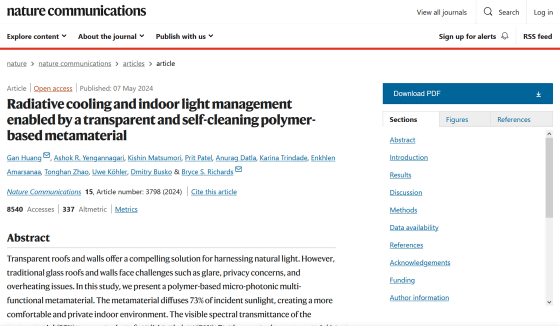A new material has been developed that is as opaque as frosted glass but allows more light in than glass and has the effect of cooling a room

Buildings can save energy by making the most of natural light, but covering walls with transparent glass has problems such as the loss of privacy because the inside is visible, and the sunlight can make the material too hot during the day. A research team at
Radiative cooling and indoor light management enabled by a transparent and self-cleaning polymer-based metamaterial | Nature Communications
https://www.nature.com/articles/s41467-024-48150-2

KIT - KIT - Media - Press Releases - PI 2024 - Innovative Materials for Sustainable Building
https://www.kit.edu/kit/english/pi_2024_037_innovative-material-for-sustainable-building.php
New material looks like frosted glass but lets in more light than a window | Popular Science
https://www.popsci.com/technology/glass-coating-privacy/
Glass is one of the most common building materials in the world, and has the advantage of allowing outdoor light to enter indoors due to its high light transmittance. For this reason, buildings that want to make effective use of natural light have large glass windows, skylights, or entire walls made of windows. However, in the summer, letting in sunlight can make the room too hot, and covering walls with transparent glass can also pose privacy issues as people inside can be seen through the glass.
To solve these problems with glass, a research team at the Karlsruhe Institute of Technology has developed a new polymer-based metamaterial that combines a variety of properties. The new material, which the research team calls 'Polymer-based Micro-Photonic Multi-Functional Metamaterial (PMMM)', is a structure in which micro-scale silicon pyramids are arranged, and the size of the square pyramids is about 10 micrometers , which is about one-tenth the diameter of a hair.

Below is an image of normal glass (left) and PMMM (right). In PMMM, 73% of the light that passes through is instantly diffused by a huge number of silicon micropyramids, so the other side of the material is opaque like frosted glass. However, the light transmittance of PMMM is 95% compared to 91% of glass, so 'the amount of light taken in is more than that of glass, but the other side is not visible'.

The silicon micropyramids also give the PMMM film superhydrophobic properties, making water droplets bead up and remove any dirt from the surface. This self-cleaning mechanism improves the maintainability of the material.

In addition, the micropyramids have the effect of radiating heat, so PMMM can provide passive radiative cooling that does not consume power. When the research team tested PMMM indoors, it was confirmed that the PMMM film cooled the surrounding temperature by 6 degrees Celsius.

Dr. Gan Huang of the Karlsruhe Institute of Technology, lead author of the paper, said: 'When used on roofs and walls, this material can create bright, non-glare, and private indoor spaces for work and living. It is estimated that photosynthetic efficiency in greenhouses is 9% higher than in greenhouses with glass roofs, so high light transmittance can increase crop yields. The material can optimize indoor solar utilization while providing passive cooling to reduce reliance on air conditioning. This solution is scalable and can be seamlessly integrated into environmentally friendly building construction and urban development plans.'
Related Posts:
in Science, Posted by log1h_ik







